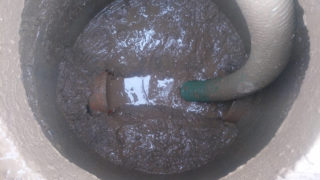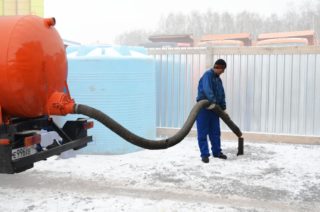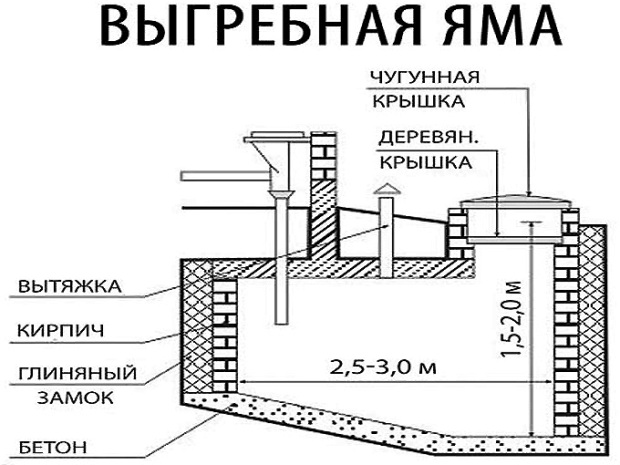The accumulation of fat in the cesspool is a common problem for summer residents and owners of private houses, disrupting the operation of the sewer system. Timely cleansing and preventive care contribute to its solution without consequences.
Effects of fat accumulation
Fat deposits on the walls and bottom of the cesspool lead to its rapid filling due to a decrease in the volume of flow. The appearance of a fetid odor from the sewer is a signal that it is time to start cleaning it. The current methods are chemical treatment and mechanical cleaning.
Chemical cleaning methods

They have several advantages:
- Resistant to various detergents.
- Decompose all kinds of waste.
- Eliminate harsh unpleasant odors.
- They work at any temperature and its sharp drops.
It is important to remember that chemicals are toxic and hazardous to humans, harmful to the environment, and corrosive to metals. With frequent use, they destroy the sewer system. When working with them, it is necessary to observe safety measures and use protective equipment.
To clean cesspools, the following are intended:
- Bleach is a budget disinfectant. Contains a large amount of carcinogens. When working with it, you must follow all the recommendations indicated on the package.
- Salt ammonium compounds - have a high disinfection effect. When combined with water, a concentrated alkali is formed, which activates decomposition processes and eliminates unpleasant odors. When interacting with household chemicals, the effectiveness of the action decreases.
- Formaldehyde is a powerful antibacterial agent that degrades all types of waste. It is a dangerous carcinogen. It is used in small quantities or in rare cases, for example, to stop the decomposition process with the release of toxic substances.
- Nitrate oxidants are substances that are used as a more gentle antiseptic for the decomposition of solid waste and fecal matter. The only drawback: nitrates formed on contact with the metal contribute to its destruction.
A feature of all chemicals is the ability to reduce the volume of fecal matter, processing of solid particles and paper.
Biologics are a combination of microorganisms and enzymes. Their use is considered safe and gentle for many reasons:
- Harmless to humans and the environment.
- By decomposing waste, they form fertile sludge, which is used as an organic fertilizer.
- They do not harm metal, plastic and other materials.
- Prevents biochemical processes that produce unpleasant odors.
- Displace pathogenic flora.
Bacteria only affect organic compounds. Their use is not possible at low temperatures.
There are three main groups:
- anaerobic - they develop without oxygen supply, which allows their use in closed pits; decompose waste, forming a sludge;
- aerobic - act with a constant supply of air; divide the contents into two fractions (purified water and silty sediment, which is used as fertilizer for plants);
- mixed - one product contains several types of bacteria.
Biological preparations are popular: "Doctor Robik", "Likvazim", "Biosept", "Septic-Biogranules". All of them are aimed at combating organic matter and fatty deposits.
Mechanical cleaning methods
- Calling a sewage truck or a sewage pump is a reliable and convenient option. Extraction of the insoluble layer at the bottom is possible if the drainage depth is no more than three meters.
- With a small volume of the cesspool, it can be cleaned manually using an ordinary bucket lowered on a rope. It is important to remember the toxicity of the waste. Before starting work, you must wear fully closed clothing, glasses, gloves, mask or respirator. The liquid fraction is preliminarily pumped out into a hermetically sealed container. With the help of a metal brush, grease deposits are removed from the pit walls. The sludge layer is removed from the bottom. After that, the walls are treated with a chemical antiseptic. The container with the contents is removed to a place designated for disposal. Released toxic substances and gases can adversely affect your well-being. Therefore, this cleaning method is not recommended to be carried out alone.
- The use of a special fecal pump simplifies the cleaning process in a similar way. You will have less contact with the dangerous mass. But you should not forget about the means of protection in this case.
Preventing the problem
To prevent the deposition of fatty accumulations on the inner surfaces of the drain pipes and the walls of the cesspool, it is necessary to carry out preventive actions:
- cleaning the drain pipes with an aqueous solution of caustic soda allows you to dissolve the accumulated fat;
- it is necessary to pump out the liquid mass in time, preventing the pit from filling completely;
- it is not recommended to throw garbage into the sewer system, which can get stuck in the pipes, which will lead to the rapid accumulation of a sludge layer at the bottom of the pit;
- the use of biological agents and chemicals that promote the breakdown of fat and other deposits;
- in winter, it is recommended to cover the pit lid with polystyrene or agrofibre to avoid freezing.
The use of modern means and methods of cleaning allows you to keep the sewer system in order. The main thing is not to forget to carry out all the necessary actions in time to clean it and prevent blockages.










